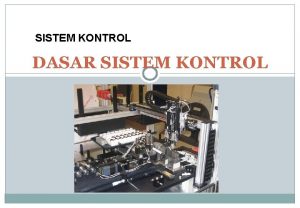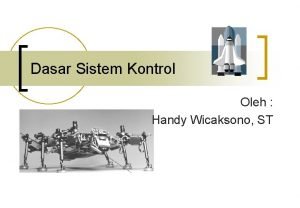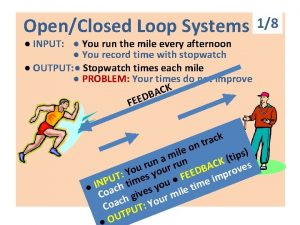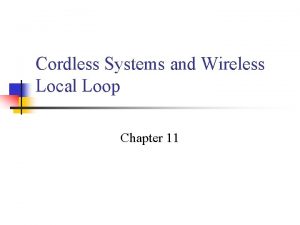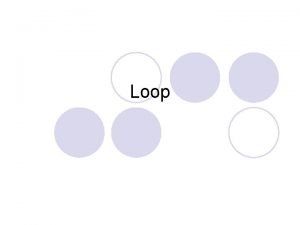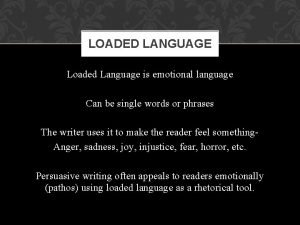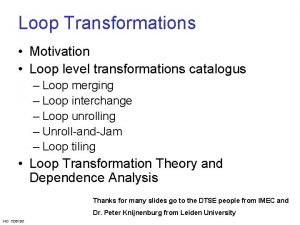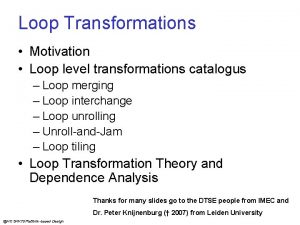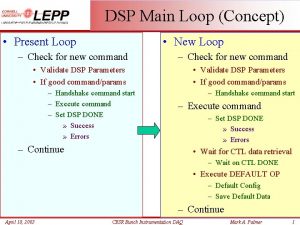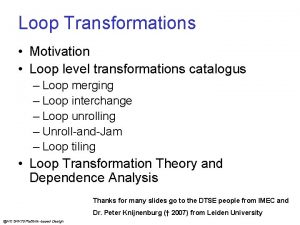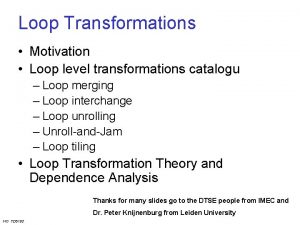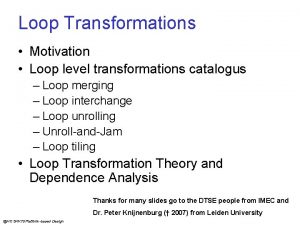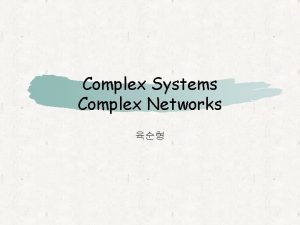The Loaded Loop A Complex Adaptive Systems CAS















- Slides: 15

The Loaded Loop: A Complex Adaptive Systems (CAS) Model of Command Control (C 2) Processes in Combat by Paul J. Hiniker, Ph. D. C 4 I Modeling, Simulation & Assessment Defense Information Systems Agency Arlington, VA 22203 Presented at the RAND Modeling of C 2 Decision Processes Workshop July 31, 2001, Mc. Lean, VA

• Problem: What are the causal effects of C 4 ISR on combat outcomes? (PBD 070 C) • Focus: C 2 decision-making • Aim: JWARS Simulation

Impact of C 4 ISR on Combat Outcome: Overview A Complex Adaptive System/Lanchester Model (Dr. Hiniker) hinikerp@ncr. disa. military, 7/31/01

Approach: Command Center as Complex Adaptive System (CAS) with Schema Prescriptions Lens Predictions Lens Descriptions Lens Schema

Command Center Schema and Congruity of Situation Assessment Cognitive Domain Informational Domain Physical Domain Perception COP Schema Description Ground Truth

Weaponry and Lanchester Force Equations In combat modeling, C 2 factors, such as use of shared COP schema, are viewed as multipliers of the force coefficients, Cf and Ce, in Lanchester equations: d. F/dt = -Ce. E and (1) Lanchester Force Equations d. E/dt = -Cf. F, where F = friendly (Blue) force size and Cf = friendly kills/sec/unit. E = enemy (Red) force size and Ce = enemy kills/sec/unit

C 2 Decision-Making and the OODA Loop: Quality Decision Loop Speed (Df) on Battlefield Exchange Ratio (Xf) Xf 1. 0 Red Losses Total Losses (%) C = Situation Awareness, t. C from COP Schema Description R = Reliability of COA Forecast , t. R from Wargame Simulation Schema Prescription t. A = Action Time t. B = Time to Feedback Df = 100(C x R)/(t. C+ t. R+ t. A+ t. B) Combat Decision Loop Xf = Df Blue Quality Decision Loop Speed (Utiles/minute) Df -- (2) Quality Decision Loop Equation

C 2 Combat Decision Superiority Derivation from Lanchester Equations DSf = (Cf x Rf) t. De / (Ce x Re) t. Df where t. D = t C + t R + t A + t. B Narrower Decision Information Superiority Cf 1. 0 Congruity of Blue View Decision Information Superiority DISf = Cf – Ce (3. 2) (%) Corollaries Congruity of Red View (%) Ce • Requires active sensors and communications for this critical information • Suggests a focused strategy for Info Ops

Results from Three Controlled Experiments with Shared COP Prototypes, 1990 -1991 Scenario: Air/Sea battle set in Persian Gulf using RESA Wargame Simulator Exp Treatment: All parties share big and little pictures fed by national and organic sensors. Control Treatment: Big picture from national sensors at CJTF. Little pictures from organic sensors at ship captains. Constant weaponry with experimentals and controls. 1990 COP Prototype · improved situation assessment accuracy (Cf from commander’s sketch) · improved shared awareness (Ns from opinion reports) · improved synchronization of action (TA, +10% speed) 1991 COP Prototypes · improved battlefield exchange ratio (Xf, +25%) While controlling for weaponry, use of shared COP schema causes improved combat effectiveness (cf. IS Value Chain)

Impact of Pace of Battle (P) on Quality Decision Loop Speed (Df) Df = log P for 0 P Quality Decision Loop Speed (Df) (Performance) Pace of Battle (P) (Yerkes-Dodson Law) (Workload)

Results from Controlled Experiment on Bounded Rationality with Variable Threats, 1987 Scenario: Identification of first arriving air threat from several on tactical air defense display. Exp Treatment: 4 simultaneous threats at 12 different arrival speeds. Control Treatment: 7 simultaneous threats at 12 different arrival speeds. · Finding: For both threat conditions, subjects performance followed Yerkes-Dodson growth curve which peaked at T* = 2. 2 seconds/threat Human decision-making performance is limited by number and speed of decision elements.

The Looming C 2 Cliff Quality Decision Loop Speed (Df) and Pace of Battle (P) on Battlefield Exchange Ration (Xf) Xf Df log P

Effective Quality Decision Loop Speed (Ds) for Nested Command Centers Sharing COP Schema NS = Shared Awareness NP = Shared Plans D 1 NS NS NP D 2 NP NS D 3 NP Ds = ( d (Ns Np ) ) (6. 0) Nested Command Centers Equation

Results from Three Military Exercises with Shared “COP” Schema, 1997 -1998 Scenario Exp Treatment Comparison Group Findings 1997 Air Force Exercise JTIDS Equipped Aircraft No JTIDS on Aircraft • 250% improvement in kill ratios for 12, 000 sorties 1998 Navy Fleet Battle Experiment Shared COP between Army Helicopters, Air Force AC 130 s, and Navy Units No Shared COP • Improved combat power and faster mission accomplishment, TA improved 50%. 1998 Army Task Force XXI Exercise Shared tactical Internet No tactical Internet • Improved combat power and 10 fold increase in lethality Even with similar weaponry, sharing a more complete picture of the battlespace is positively correlated with improved combat effectiveness

Needed Results from Controlled Experiment with Shared Planning * Controlled experimentation affords the only method for unequivocal testing of causal hypotheses Scenario: Air/Sea battle set in Persian Gulf with CJTF on carrier and two ship captains. Exp Treatment: CJTF and both ship captains comprise a CAS sharing COP schema fed by organic sensors and overhead surveillance and reconnaissance and with shared CAP white board for collaborative planning. Control Treatment: Big picture from national sensors at CJTF. Little picture from organic sensors at ship captains. Phone communications. Constant weaponry with experimentals and controls. Expected Results: Higher Df and higher Xf in experimental condition; much higher Df and Xf with self organization upon withdrawing CJTF from operation.
 Dicapine
Dicapine Diagram blok oven listrik
Diagram blok oven listrik Fifth gear loop the loop
Fifth gear loop the loop Open loop vs closed loop in cars
Open loop vs closed loop in cars Manakah yang lebih baik open loop atau close loop system
Manakah yang lebih baik open loop atau close loop system Do while loop
Do while loop Ulnar loop on right hand
Ulnar loop on right hand Multi loop pid controller regolatore pid multi loop
Multi loop pid controller regolatore pid multi loop Bruno dislikes sitting on the beach
Bruno dislikes sitting on the beach Ghon complex
Ghon complex Quiz on compound sentences
Quiz on compound sentences Oedipus complex and electra complex
Oedipus complex and electra complex Psychodynamic theory
Psychodynamic theory Latent fixation
Latent fixation Closed system example
Closed system example Dect protocol architecture
Dect protocol architecture

